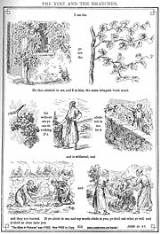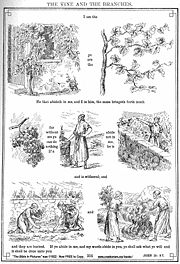
The Vine
Encyclopedia

Parable
A parable is a succinct story, in prose or verse, which illustrates one or more instructive principles, or lessons, or a normative principle. It differs from a fable in that fables use animals, plants, inanimate objects, and forces of nature as characters, while parables generally feature human...
given by Jesus
Jesus
Jesus of Nazareth , commonly referred to as Jesus Christ or simply as Jesus or Christ, is the central figure of Christianity...
in the New Testament
New Testament
The New Testament is the second major division of the Christian biblical canon, the first such division being the much longer Old Testament....
found only in the Gospel of John
Gospel of John
The Gospel According to John , commonly referred to as the Gospel of John or simply John, and often referred to in New Testament scholarship as the Fourth Gospel, is an account of the public ministry of Jesus...
.
Old Testament
There are numerous Old TestamentOld Testament
The Old Testament, of which Christians hold different views, is a Christian term for the religious writings of ancient Israel held sacred and inspired by Christians which overlaps with the 24-book canon of the Masoretic Text of Judaism...
passages which refer to Israel
Israel
The State of Israel is a parliamentary republic located in the Middle East, along the eastern shore of the Mediterranean Sea...
as a vine: Ps 80:8-16, Isa 5:1-7, Jer 2:21, Ezek 15:1-8, 17:5-10, 19:10-14, and Hos 10:1. The vine became symbolic of Israel, and even appeared on some coins issued by the Maccabees
Maccabees
The Maccabees were a Jewish rebel army who took control of Judea, which had been a client state of the Seleucid Empire. They founded the Hasmonean dynasty, which ruled from 164 BCE to 63 BCE, reasserting the Jewish religion, expanding the boundaries of the Land of Israel and reducing the influence...
.
The Old Testament passages which use this symbol appear to regard Israel as faithless to Yahweh
Yahweh
Yahweh is the name of God in the Bible, the God of Abraham, Isaac, Jacob, Jews and Christians.The word Yahweh is a modern scholarly convention for the Hebrew , transcribed into Roman letters as YHWH and known as the Tetragrammaton, for which the original pronunciation is unknown...
and/or the object of severe punishment. Ezek 15:1-8 in particular talks about the worthlessness of wood from a vine (in relation to disobedient Judah). A branch cut from a vine is worthless except to be burned as fuel. This appears to fit more with the statements about the disciples
Disciple (Christianity)
In Christianity, the disciples were the students of Jesus during his ministry. While Jesus attracted a large following, the term disciple is commonly used to refer specifically to "the Twelve", an inner circle of men whose number perhaps represented the twelve tribes of Israel...
than with Jesus’ description of himself as the vine.
Ezek 17:5-10 contains vine imagery which refers to a king of the house of David, Zedekiah
Zedekiah
Zedekiah or Tzidkiyahu was the last king of Judah before the destruction of the kingdom by Babylon. He was installed as king of Judah by Nebuchadnezzar II, king of Babylon, after a siege of Jerusalem to succeed his nephew, Jeconiah, who was overthrown as king after a reign of only three months and...
, who was set up as king in Judah by Nebuchadnezzar. Zedekiah allied himself to Egypt and broke his covenant with Nebuchadnezzar (and therefore also with God), which would ultimately result in his downfall (17:20-21). Ezek 17:22-24 then describes the planting of a cedar sprig which grows into a lofty tree
Lebanon Cedar
Cedrus libani is a species of cedar native to the mountains of the Mediterranean region.There are two distinct types that are considered to be different subspecies or varieties. Lebanon cedar or Cedar of Lebanon Cedrus libani is a species of cedar native to the mountains of the Mediterranean...
, a figurative description of Messiah
Messiah
A messiah is a redeemer figure expected or foretold in one form or another by a religion. Slightly more widely, a messiah is any redeemer figure. Messianic beliefs or theories generally relate to eschatological improvement of the state of humanity or the world, in other words the World to...
. But it is significant that Messiah himself is not described in Ezekiel 17 as a vine, but as a cedar tree. The vine imagery here applies to Zedekiah’s disobedience.
Is it a parable?
Several authors such as Barbara Reid, Arland Hultgren or Donald Griggs comment that "parables are noticeably absent from the Gospel of John". According to the Catholic EncyclopediaCatholic Encyclopedia
The Catholic Encyclopedia, also referred to as the Old Catholic Encyclopedia and the Original Catholic Encyclopedia, is an English-language encyclopedia published in the United States. The first volume appeared in March 1907 and the last three volumes appeared in 1912, followed by a master index...
article on Parables: "There are no parables in St. John's Gospel" and according to the Encyclopædia Britannica
Encyclopædia Britannica
The Encyclopædia Britannica , published by Encyclopædia Britannica, Inc., is a general knowledge English-language encyclopaedia that is available in print, as a DVD, and on the Internet. It is written and continuously updated by about 100 full-time editors and more than 4,000 expert...
article on Gospel of St. John: "Here Jesus' teaching contains no parables and but three allegories, the Synoptists
Synoptic
Synoptic is derived from the Greek words σύν and ὄψις , and describes observations that give a broad view of a subject at a particular time. Specific uses include:*Synoptic scale meteorology*Synoptic Gospels*SynOptics...
present it as parabolic through and through." These sources all suggest that the passage is better described as a metaphor than a parable. However, some writers, notably John Calvin
John Calvin
John Calvin was an influential French theologian and pastor during the Protestant Reformation. He was a principal figure in the development of the system of Christian theology later called Calvinism. Originally trained as a humanist lawyer, he broke from the Roman Catholic Church around 1530...
, referred to the passage by a Latin term that is typically translated into English as a "parable".
Authenticity
The Jesus SeminarJesus Seminar
The Jesus Seminar is a group of about 150 critical scholars and laymen founded in 1985 by Robert Funk under the auspices of the Westar Institute....
labelled the story of the vine, and the farewell discourse as a whole, inauthentic ("black"). However, the work of the Jesus Seminar has been criticized by other scholars.
Text
From John 15:1-6 (KJV)15:1 I am the true vine, and my Father is the husbandman.
15:2 Every branch in me that beareth not fruit he taketh away: and
every branch that beareth fruit, he purgeth it, that it may bring
forth more fruit.
15:3 Now ye are clean through the word which I have spoken unto
you.
15:4 Abide in me, and I in you. As the branch cannot bear fruit of
itself, except it abide in the vine; no more can ye, except ye abide
in me.
15:5 I am the vine, ye are the branches: He that abideth in me, and
I in him, the same bringeth forth much fruit: for without me ye can
do nothing.
15:6 If a man abide not in me, he is cast forth as a branch, and is
withered; and men gather them, and cast them into the fire, and they
are burned.

